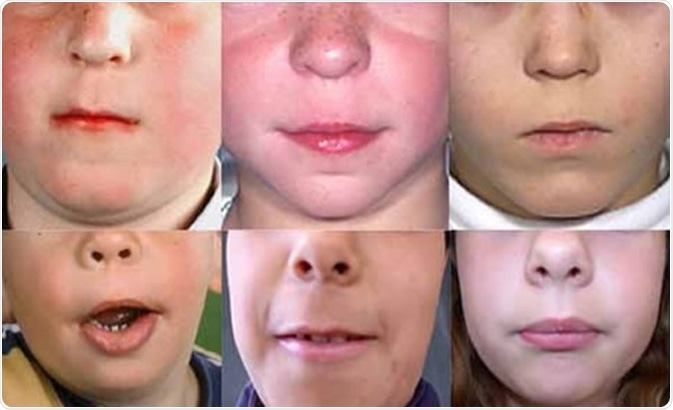Aarskog syndrome is a rare inherited genetic disorder that affects the skeleton, genitals, muscles, stature, and overall appearance. The fingers, toes, and face are the major parts that are frequently affected. Males are considered to be the primary victims of this syndrome, with a few cases of females being affected. Aarskog syndrome is known to inhibit growth, which may not be identified until the age of three.

Long philtrum, a symptom of Aarskog-Scott syndrome. Credit: Genetics Home Reference
Causes of Aarskog Syndrome
A mutation of the FGD1 gene, otherwise known as the faciogenital dysplasia 1 gene, is the cause of this syndrome. This gene is located in the arm structure (at Xp11.21 position) of the X-chromosome and thus it is considered an X-linked inherited disorder.
Mode of Genetic Exhibition
Normally, of the 23 pairs of chromosomes that a human possesses, the last pair is anasomal, meaning that this chromosome determines the sex of a child. Male offspring have one X and one Y chromosome, while for a female there are two X chromosomes.
This particular disorder is X-linked recessive. Hence, in a male who has only one X-chromosome, if a mutation happens, this will likely result in the development of the disease.
In females who have two X chromosomes, if one allele is mutated, it does not show any major effects as the allele on the other X-chromosome compensates and they become carriers of the syndrome. Such people never exhibit any signs of the disease.
The Pride: 15-year-old boy with rare genetic condition finds his voice through art therapy
Mode of gGenetic Transformation
Case 1: Inheritance from a carrier mother and a normal father
Let us consider the genetic pattern of the affected mother as X1 X, where “X1” is the mutated allele. In this case, the father would be normal with the XY pattern.
While transferring traits to the next generation, a child can have any one of the following patterns: X1X, X1Y, XX, or XY. Here, there is a 50% chance of inheritance of the affected gene. The girl child with this trait will act as a carrier due to the presence of only one affected X-allele, while a boy child who has acquired the trait will surely be affected by the syndrome. Thus, the male child of an affected mother is more prone to the syndrome than a female child.
Case 2: Inheritance from an affected father and a normal mother
Let us now consider the genetic pattern of the affected father as X1Y, where X1 is the mutated gene. Here, the mother would be normal with the XX pattern.
In the genetic transfer that happens in this case, the possible inheritances are X1X and XY. This shows that the boy child of an affected father and a normal mother will not get the syndrome, while the girl child of this pair remains a carrier.
Case 3: When mother is carrier and father is affected
In this case, the genetic pattern of the mother may be X1X and for the father it would be X1Y. The possible inheritance here would be X1X1, X1Y, X1X, and XY. Of the two chances of a female child, one can be highly infected while the other remains a carrier. Similarly, there is a 50% chance for the boy child to be affected while the remaining 50% will be normal.
The above cases can differ accordingly when the mother has the disease , which is a very rare case.
Diagnosis of Aarskog Syndrome
Most signs of Aarskog syndrome are visible from the time of birth. Persons with this syndrome have typical facial abnormalities, which is diagnostic in most cases. Changes are commonly seen in the lower, middle, and upper portions of the face. For example:
- widow’s peak hair (scalp hair growth in the center of the forehead)
- excessive distance between the eyes, known as ocular hypertelorism
- expanded width of the forehead
- descending slant of the opening of the eye
- drooping of the eyelids
Aarskog syndrome diagnosis for children is done by examining of these facial changes as well as other genital and skeletal features. The physician might execute a full-body examination for the child. The family medical history also plays a vital role in diagnosis of this disease. If a child is suspected to have Aarskog, the doctor may advise for a genetic test to identify the mutation in the child’s FGD1 gene.
This test is only available in research laboratories. X-rays also help in determining the severity of the disease.
In rare cases, families tend to notice the hereditary occurrences of Aarskog syndrome. In such cases ultrasound examination of feet, face, and hands is done to identify the disease. Clinically, this is not widely used because the syndrome does not have any medical severities.
Sources
- Encyclopedia.com, www.encyclopedia.com/.../aarskog-syndrome-0
- Medline Plus, Aarskog Syndrome, https://medlineplus.gov/ency/article/001654.htm
- NORD, Aarskog Syndrome, https://rarediseases.org/rare-diseases/aarskog-syndrome/
- NIH, Aarskog Syndrome, https://rarediseases.info.nih.gov/diseases/4775/aarskog-syndrome
- Medigest, Aarskog Syndrome
- Women’s Health and Wellness, Aarskog Syndrome, http://www.empowher.com/media/reference/aarskog-syndrome
Further Reading